“Sales efficiency” is more than just a slogan—it’s a math problem every company wants to solve.
Any organization can hire more warm bodies to close more deals, but that’s not a recipe for sustainable growth. And with profit margins top of mind, it’s not a viable option.
If you want your sales team to convert buyers faster and more frequently using the resources they already have, you have to start by fixing your efficiency formula.
Keep reading to learn:
- How to calculate sales efficiency
- What’s mucking up your sales efficiency
- Why your tooling makes all the difference
Sales efficiency by the numbers
“Sales efficiency” is basically another way of saying “do more with less.”
If your sales team generates more revenue without adding more overhead—or brings in the same amount of revenue while incurring lower costs—it’s an efficiency win.
And—surprise, surprise—efficiency is something every company is after (most SaaS companies benchmark themselves using the “magic number”). The more revenue you generate while keeping costs low, the better your profits and the rosier your long-term operating outlook.
To calculate your sales efficiency, just divide the revenue your sales team generates by how much it costs to make those sales:
Obviously, the higher the result, the better (any number less than 1 means you’re in the red).
Say your sales team brings in $1M in sales during a single quarter and it costs $500K to do it (salaries, training costs, software licenses—you get the idea). Your sales efficiency ratio would be 2 (which is nothing to sneeze at—any number between 1 and 3 is considered good).
But if you lowered your costs to $250K and still generated $1M in sales, your sales efficiency ratio would tick up to 4. Cue the popping of bottles.
Most of the heavy lifting comes from determining exactly what counts as “cost” (companies typically combine marketing and sales expenses, as well as indirect operating costs, such as office space).
But no matter how you slice and dice your numbers—gross revenue vs. net revenue, quarterly sales vs. annual sales, team-wide performance vs. rep-by-rep performance—the goal is always the same: Sell more without spending more.
Sales efficiency and sales effectiveness aren’t the same thing
The terms “sales efficiency” and “sales effectiveness” are sometimes used interchangeably, but there’s a difference.
If sales efficiency is all about performing better with current resources (or performing the same with fewer resources), sales effectiveness is all about performing better—full stop.
Put another way, you can’t be efficient without being effective, but you can be effective without being efficient.
What you want is the best of both worlds: reps who not only knock on more doors in the time allotted to them, but also win more at each stage of the buyer journey.
What’s eating your sales efficiency
A low sales efficiency score indicates you have a problem, but it doesn’t tell you exactly what that problem is.
Maybe your reps require more training. Or maybe you need to revisit your ideal customer profile and refine your messaging.
Sometimes the issue is out of sales teams’ hands altogether. For instance, if your organization is spending too much money to generate marketing-qualified leads, it’s going to hurt your efficiency.
That said, there are three common efficiency killers that may be fouling up your formula:
- Buyer visibility
- Time management
- Tool complexity
1. Buyer visibility
Customer expectations are higher and buying budgets are smaller. In other words, crossing the closed-won finish line is harder than ever.
Sales reps have to kick-start conversations with sales-averse buyers who are more than happy to do their own research (reps now only get about 5% of a buyer’s time).
This makes personalized outreach all the more important, but reps usually have to make do with vague (and likely outdated) buyer intent signals or impractical lead and account scores.
The insights they really need—the signals that reveal buyer identity, intent, and context—are spread across a wide range of digital channels that are difficult to find or follow up on at scale (aka the dark funnel).
Based on research of Common Room customers, nearly 30% of open pipeline is discovered in the dark funnel before a record ever gets created in a CRM (and more than a quarter of closed-won deals are discovered there first). Most reps are blind to this activity.
2. Time management
Time is money. And too many reps are spending it on tasks other than selling.
Data shows that sales reps spend 72% of their week on non-selling activities on average. This includes everything from lead prioritization and prospect deep-dives to updating CRM records.
Disorganized data and inefficient tooling create a perfect (and time-consuming) storm.
Reps spend all day trying to cobble together a view of the customer, make sure their high-intent prospects are also high-fit, and craft the perfect message. Or, worse yet, they don’t try at all and end up reaching out to the wrong people with the wrong pitch.
Lost opportunities and slower sales cycles inevitably follow.
3. Tool complexity
The sales tech stack is getting bigger and more expensive. It’s also getting more unwieldy.
Software licenses themselves don’t come cheap. But when you add on the cost of tabbing back and forth between tools just to execute on a straightforward sales play, you see that SaaS subscriptions aren’t the only thing dragging down sales efficiency.
Data shows that sales teams now use an average of 10 tools to close deals. And siloed sales tools (especially when they’re not expressly designed for sales teams) are time sucks.
It’s no wonder the vast majority of sales teams (94%) plan to consolidate their tech stacks over the next year.
With the insights they need chained to different technologies, it’s that much harder for reps to make sense of the data they have or take action on it without first having to push it to yet another tool.
How Common Room helps you boost sales efficiency
Sales reps are struggling with limited insights, time-consuming tasks, and complicated workflows. Sales efficiency suffers as a result.
Here’s how Common Room can help:
Build bigger (and clearer) pipeline
Common Room centralizes, deanonymizes, and enriches all your digital interaction, product, and CRM data and serves it up in one sales-friendly location.
With dozens of natively built and fully managed integrations with popular channels and sales technologies, reps can surface new, high-propensity buyers from previously unseen signals.
This makes it easy for sales teams to work a larger pool of prospects and get full visibility into every person and organization in the process.
🎤 "Common Room gives our go-to-market team members daily feeds of users showing intent across multiple channels—all in one place. Over 50% of our meetings come from Common Room."
—Tim Hughes, Vice President of Sales at Temporal
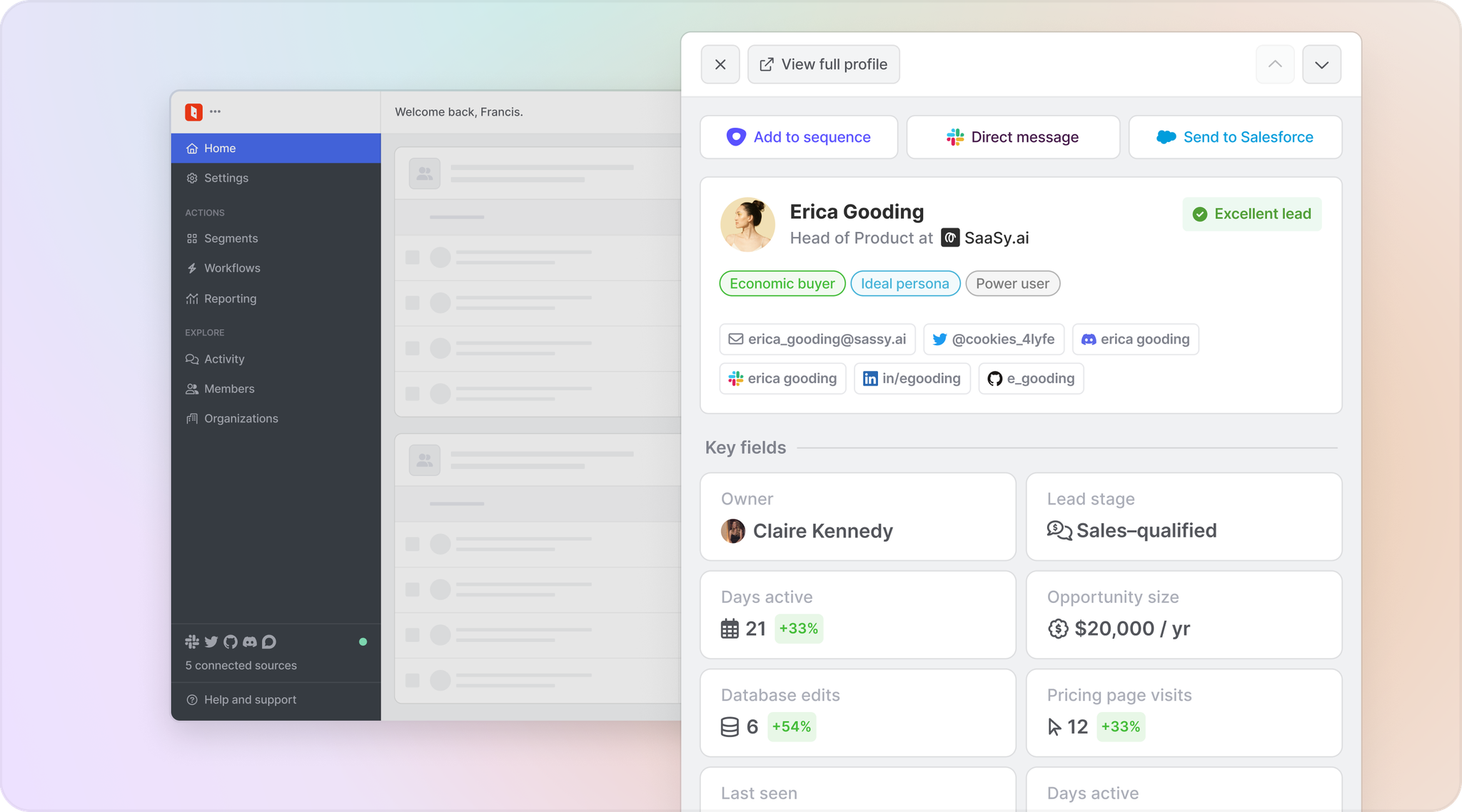
Even better, reps can use AI-powered lead and account scoring to focus on the people and companies most likely to buy. Proprietary machine learning models can be fine-tuned using your historical customer data to pinpoint which individuals and accounts reps should pay attention to.
Reps can make sure they never miss a signal—or lack visibility into the people behind the buying behaviors.
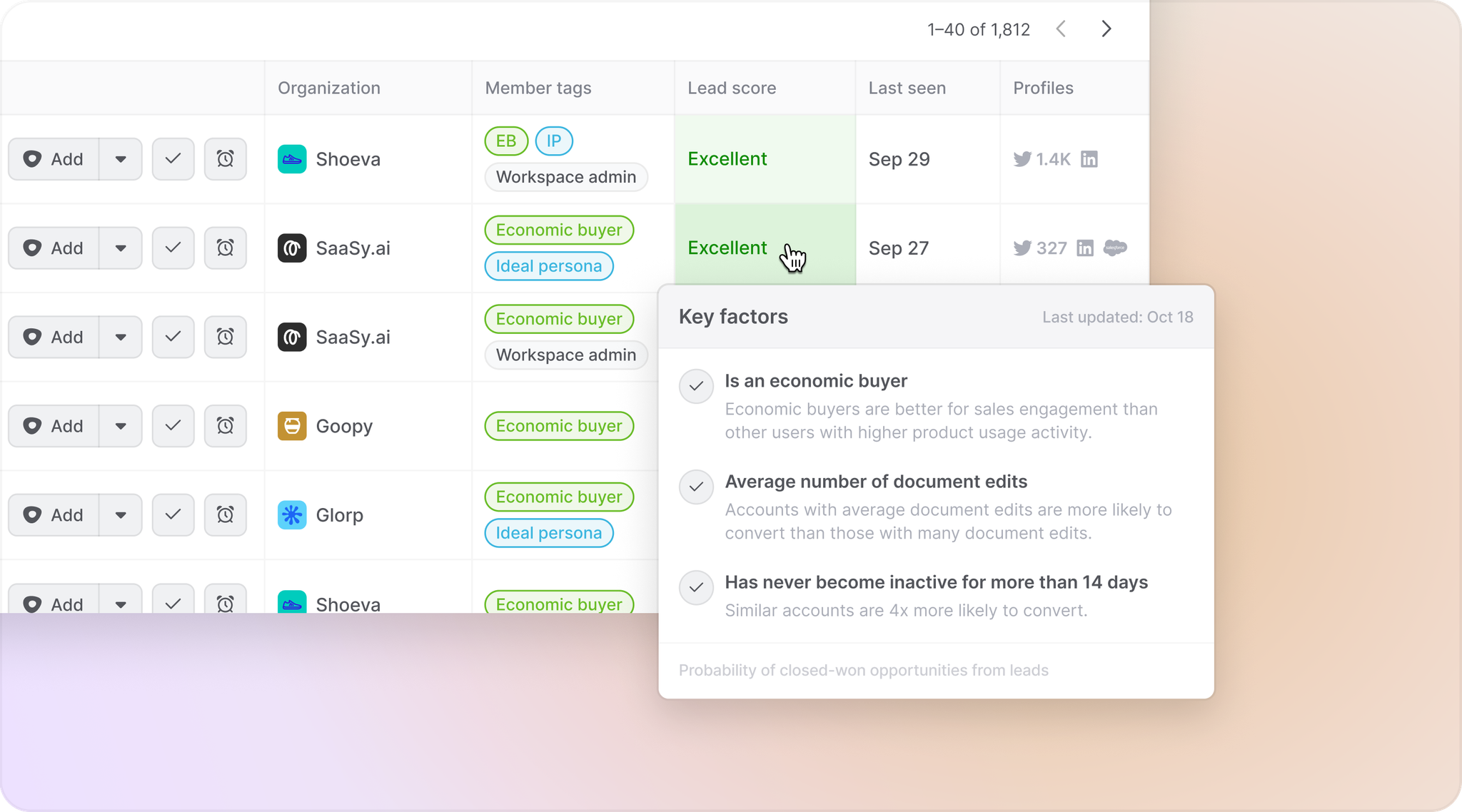
Speed up time to conversion
Common Room’s user-friendly filters and tags take the grunt work out of prospect research and lead qualification.
Reps can hone in on high-fit opportunities—whether based on job title, organization size, annual revenue, economic buying power, persona match, and more—with the click of a button.
This makes it easy for reps to prioritize opportunities and focus their outreach on the right people.
🎤 "Common Room has made it easier for our SDRs and AEs to book more and better meetings. It’s our favorite sales tool here. One of our AEs called it 'my closest friend.'"
—Tyler Hayden, Director of Sales Development at Pulumi
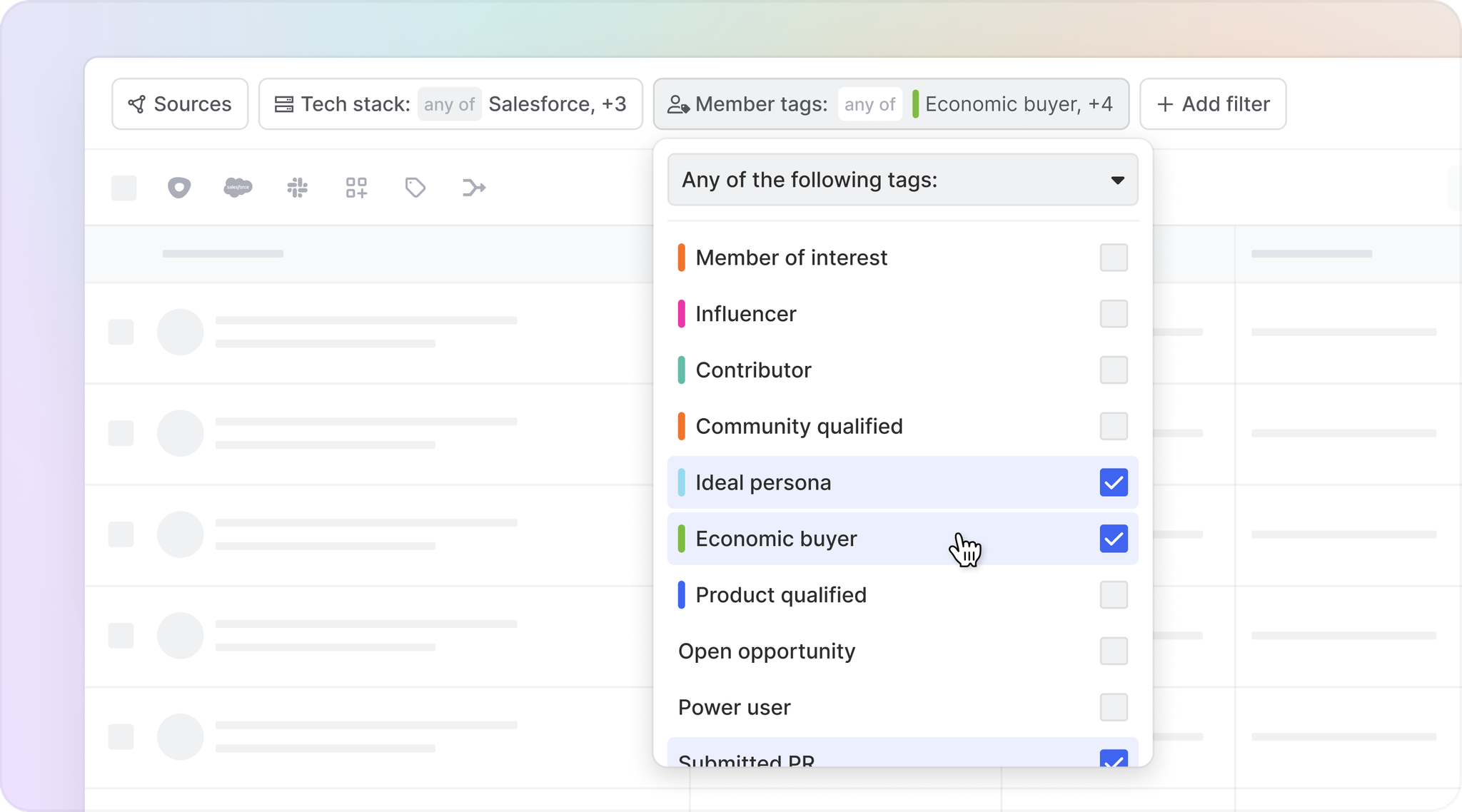
With easy access to buyers’ cross-channel activities—including actions and conversations across social media, community forums, open-source repositories, and more—reps can quickly see what people are saying and doing and where they’re saying and doing it.
Reps can inform their outreach with real-time activity and reach out on the channels where buyers spend their time.

Run every sales play from one place
Common Room’s intelligent automations make lead management and buyer outreach a breeze.
Reps can automatically add leads and accounts to reactive segments for different sales plays.
This makes it easy for reps to monitor, report on, and engage multiple customer cohorts from one location. They can add prospects to personalized Outreach sequences, send Slack and LinkedIn DMs to warm leads, and sync buyer records with Salesforce—all without the need to switch between different tools.
🎤 "Common Room made the operationalization process easy and within a few days we were off to the races. Our sales team has realized real results with meetings booked."
—Aisha Nins, Senior Sales Operations Program Manager at Apollo GraphQL
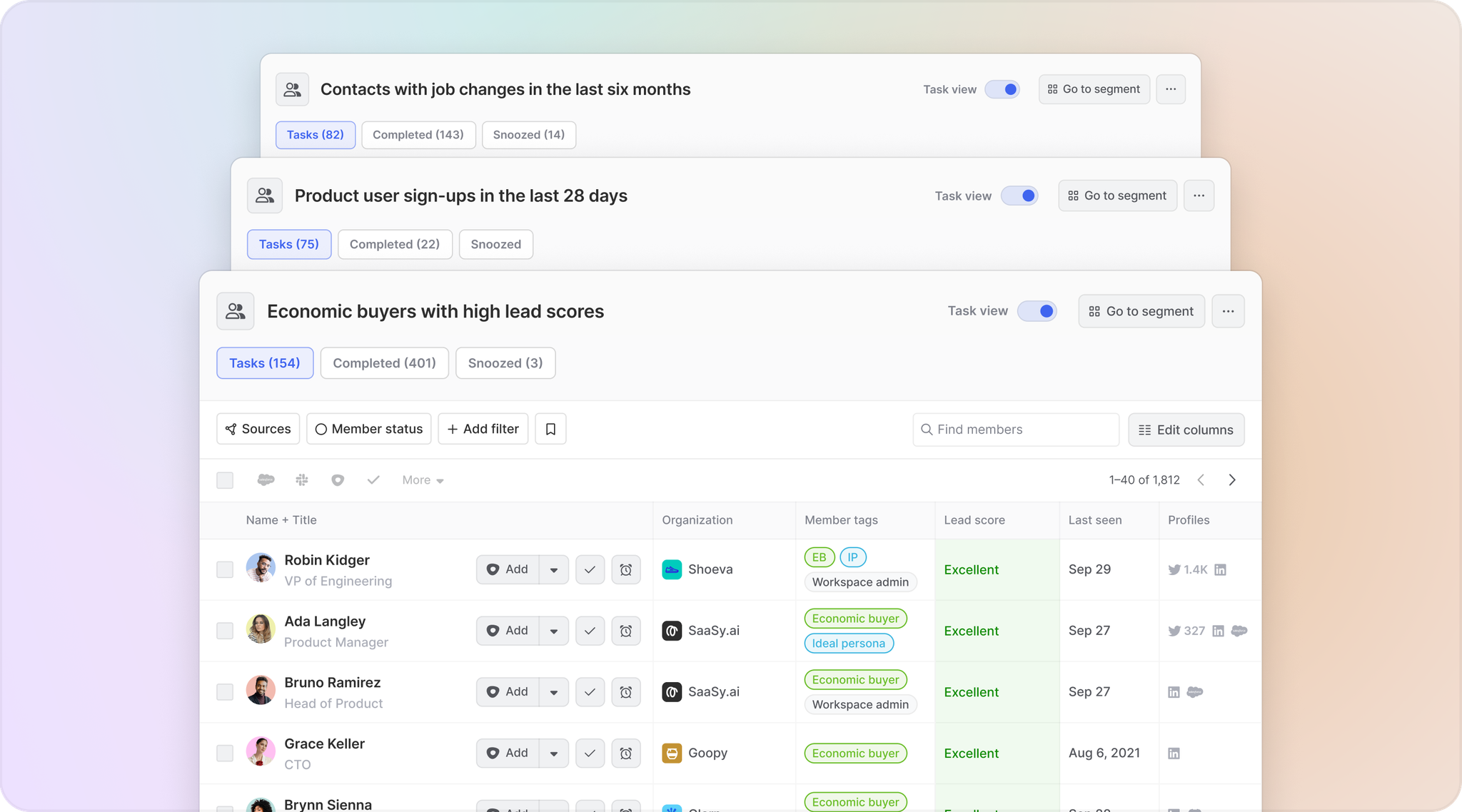
Meanwhile, automated team alerts allow reps to keep track of any buyer (and any buyer activity) they care about and get notified in real time.
Reps can stay up to date on all buyer movements and be ready to reach out at the right moment.
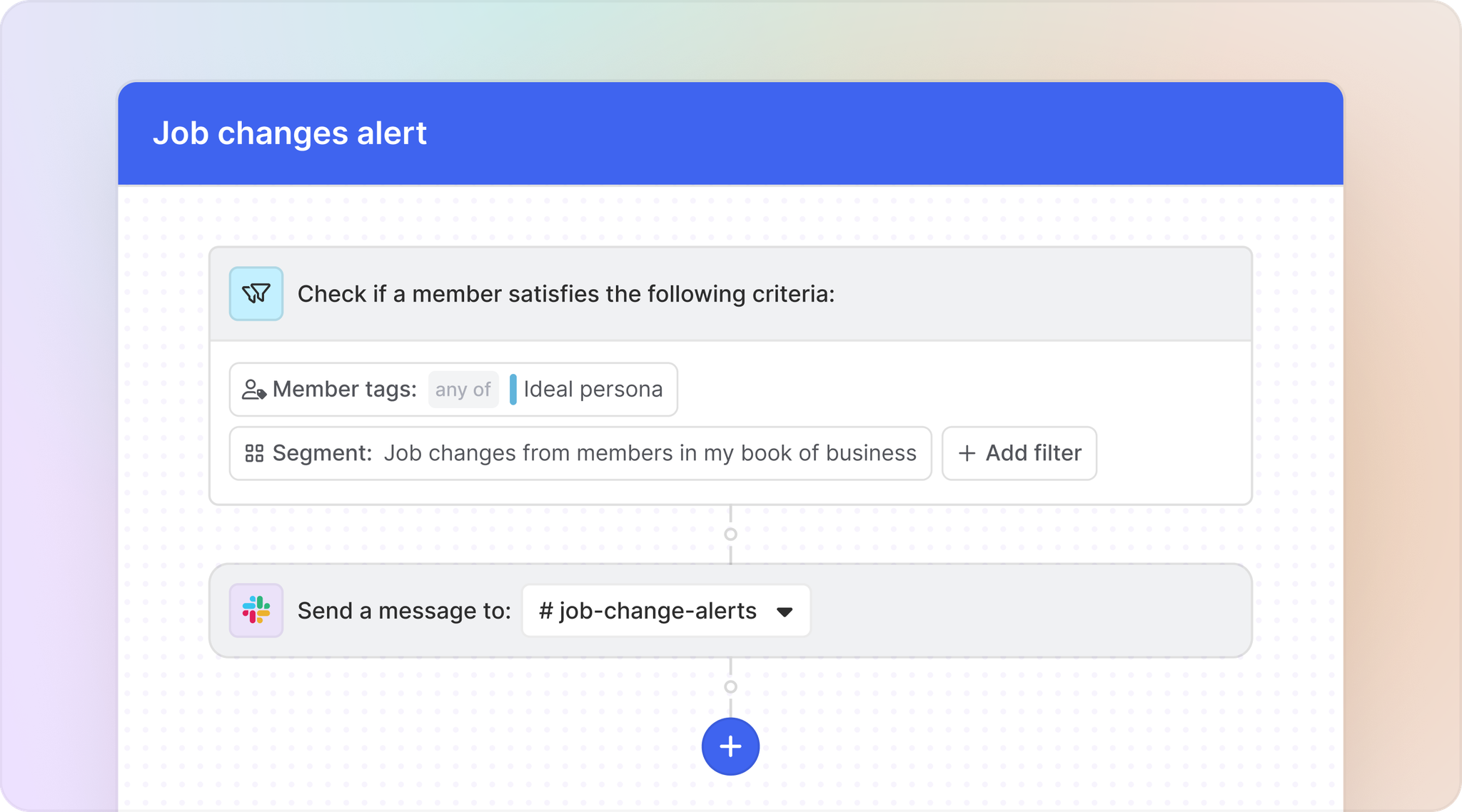
“Sales efficiency” is now every sales team’s motto.
It’s also an equation.
If you don’t like how the math is shaking out, it may be time to add better tooling to the mix.
Supercharge your sales efficiency with Common Room
Ready to see how Common Room helps you build more sales pipeline and close more deals faster?

